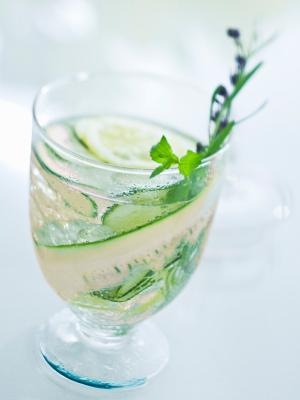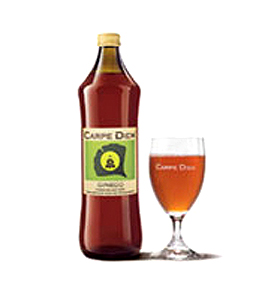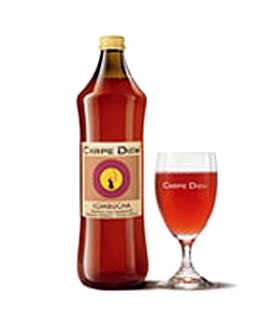 |

| |

Carpe Diem Botanic Water transports you to a spa...but also pairs with your most sophisticated dinner courses. Photo by Maria Bacarella | IST. |
| WHAT IT IS: Alpine spring water infused with herb and fruit botanicals, and beneficial kombucha and ginkgo teas. |
| WHY IT’S DIFFERENT: The botanical infusions are sophisticated; the teas are interesting; both offer different flavor alternatives to the usual soft drink lineup. |
WHY WE LOVE IT: A little bit fizzy, a little bit sweet, a little bit herbal, a lot different. Carpe Diem Botanic Waters are a quick spa staycation...and also non-alcoholic alternatives to cocktails and wine. |
| WHERE TO BUY IT: Available at Whole Foods Markets and Wild Oats nationwide. Online at VolvicSupplynet.CMA.com. |
|
|
 |

Carpe Diem:
Seize The Botanic Water
Page 3: Ginkgo & Kombucha Tea
Click on the black links below to visit other pages
MORE TO DISCOVER
|
Ginkgo & Kombucha Teas
Unlike the botanic waters, which are naturally sweetened with pear juice, the teas have a lot of added sugar (fructose—and too much of it for our taste). They seem a bit of a paradox: While these are the two items that have the most beneficial healthy ingredients (ginkgo and kombucha, respectively), they also have the most sugars: 21g and 13g, respectively. Granted, kombucha is a sugared drink—it must have sugar in for the fermentation process to take place. But consumers may wonder if anything labeled a “supplement” should be so sugary.

Green tea with ginkgo biloba. |
Ginkgo Tea
Carpe Diem Ginkgo is a high-antioxidant green tea with an extract from the leaves of the ginkgo biloba tree. It also includes dextrose, a form of glucose, which is a primary (and quick) source of energy for the brain. There’s also some fructose, a sugar that’s sweeter than sucrose (table sugar) with a lower glycemic value, which is the natural sugar in many fruits and honey. (See our Guide To Sweeteners.)
Fossils related to the modern ginkgo biloba tree date back 270 million years. It is a tree shrouded in myths and legends: In ancient times, ginkgo trees protected the temples of China and Japan from evil spirits. Tea made from its leaves provided mental vitality. Perhaps as proof of its life-enhancing powers, four ginkgo trees growing from one to two kilometers from the center of the 1945 nuclear bomb blast in Hiroshima were among the few living things to survive the blast.
|
Modern medicine has confirmed ancient beliefs: Substances within the ginkgo leaf do help with memory and concentration and may inspire creativity and receptiveness.* Many people worldwide now take ginkgo in supplement form.
*Some studies indicate that it may also help with blood flow, fight free radicals (i.e., serve as an antioxidant) and help with cardiovascular, renal, respiratory and central nervous system disorders.
Sugar Count
This beverage may be exotic for American tastes. There is a very floral, rose-like flavor and aroma, crossed with a flavor reminiscent of roots and herbs (and in some ways, of some alcohol-based cough syrups, in a pleasantly familiar way). To make it palatable, the manufacturers have more than doubled the amount of sugar; instead of 35 calories per 8-ounce serving, there are 85 calories (or more than 170 calories per 16.9-ounce bottle). The calories come from 21g of sugar per serving, or seven teaspoons of sugar; an equivalent amount of Coke or Pepsi has 27g.
Still, those who love the flavor of rose (very popular in Middle Eastern cuisine) and sugared drinks should enjoy it. The floral flavor and high sugar content makes Ginkgo less of a food-pairing drink. At your next office conference, bring in the Carpe Diem Ginkgo instead of other soft drinks. It may help people stay more focused—after they get done focusing on interesting features of the beverage itself.
Kombucha Tea
Kombucha (kom-BOO-cha) refers to both the fermented, sweetened tea beverage and the yeast used to brew it, known as the starter or the kombucha “mushroom,” a symbiotic colony of yeast and lactobacillus bacteria that has the shape of a button mushroom cap (read more about the kombucha mushroom). The starter culture transforms the tea, much as apple juice is fermented into cider, so that layers of tartness (a hint of vinegar) and pétillance (fizziness) develop.
Use of kombucha dates back to the Qin (Tsin) Dynasty of China (221 B.C.E.); it was used as a restorative or healing drink, and was introduced to the West via Russia, where it arrived before the Industrial Revolution (and where it remains very popular—read more about the history of kombucha). While kombucha has been touted as everything from a cure for baldness to cancer to a longevity aid, its health benefits are probably largely as a detoxifying tonic and a mild digestif (i.e., it aids in digestion—read more about the health benefits of kombucha).
|

Kombucha tea.
|
While kombucha can be made with any type of tea, the Carpe Diem version is based on an herbal tea mixture, sweetened with fructose. Kombucha cultures and lactobacilli are added (see a recipe that details kombucha production). In the fermentation process, beneficial organic acids and carbohydrate-digesting enzymes are formed. From a modern scientific standpoint, the detoxifying benefits are believed to come from the glucuronic acid that is created during fermentation, not from the yeasts and bacteria in the culture, although a clinical trial has yet to be published in any scientific journal.
While many kombucha teas have undertones of vinegar (a result of the fermentation process, and a very compelling flavor note), this is the sweetest, most soda-like kombucha we have tasted—think of it as a merger of red soda and digestif. Here, the fermentation manifests itself in a light, beer-like scent and flavor nuance, with a hint of vinegar underneath. This will make converting to it easy for soda drinkers (at least, those who are not put off by the beer notes), who want to enjoy the health benefits of kombucha.
Sugar Count
Kombucha has less sugar than Ginkgo, 13g (slightly less than 3 teaspoons), and 55 calories per 8 ounce serving. However, for a more serious kombucha, we prefer the Kombucha Wonder Drink line, which is made in eight flavors, all more complex and sophisticated than Carpe Diem Kombucha (and organic to boot). By comparison, the majority of Kombucha Wonder Drink flavors, in 8.5 ounce bottles, have 8g sugar. In sum: more flavor, less sugar.
FOR ADDITIONAL INFORMATION, special offers,
contests, opinion surveys, THE NIBBLE
back issues archive, product gift-finder and more,
visit the home page of TheNibble.com.
Do you have friends who would enjoy THE NIBBLE?
Click here to send them an invitation to sign up for their own copy. |
© Copyright 2004-2025 Lifestyle Direct, Inc. All rights
reserved. All information contained herein is subject to change at any time
without notice. All details must be directly confirmed with manufacturers, service
establishments and other third parties. The material in this e-zine may not
be reproduced, distributed, transmitted, cached, or otherwise used, except with
the prior written permission of Lifestyle Direct, Inc.
|
 |



|
 |